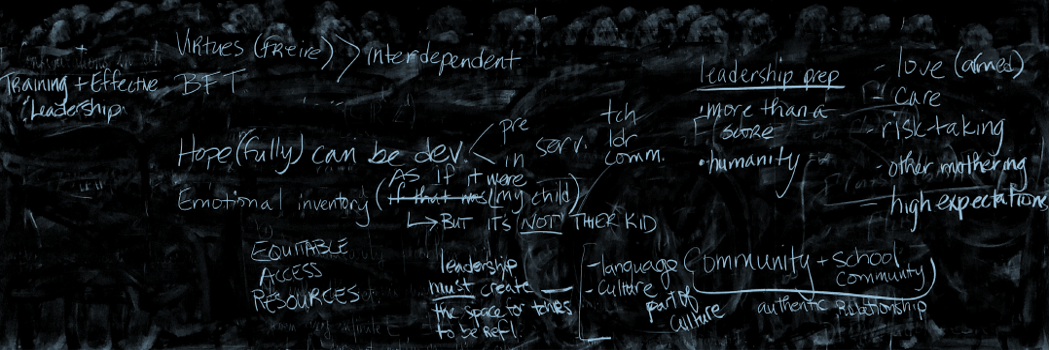Ladson-Billing’s (2019) lecture explores the power in controlling a narrative and the ability to construct context that does not align with the lived experience of folks on the ground. The story Ladson-Billings (2019) shares about the conversation with the media surrounding the flint water crisis is parallel to the many stories that surround the School to Prison Pipeline (STPPL) and Student mental health. The context that dominants the narratives surrounding the STPPL is a co-opted (neo-liberal) story of “bad schools” and “bad students”. This completely excludes the lived experiences of student interactions with metal detectors (and more) and the effects on student performance and mental health (Dixson, 2017; Ladson-Billings and Tate, 1995; Wilson, 2014). The context to make sense of these facts lies within the everyday experiences of those directly impacted (Ladson-Billings, 2019). Dixson (2017) precedes Dixson and Anderson (2018) and offers some insights to activism in education particularly looking at BLM movements to disrupt systems of oppression within education. The disruptions primarily led by young people help to re-center the narrative not just on the targeting of Black and Brown students but the acts of resistance that follow (Dixson, 2017). The social movements and direct actions were a key part in creating restorative/transformative justice approaches to care in schools (Beauboeuf-Lafontant, 2020; Dixson, 2018; Dixson and Anderson, 2018; Wilsong, 2014; Wilson, 2015). Lastly, a quote from my mother comes to mind “I will tell you who you are once you tell me the company you keep”. This week’s reading list were mostly comprised of authors I am familiar with and sources I have already examined and covered. I feel like I am in good company.
Below are some thoughts/ideas/questions I am marinating on
- How might transformative leadership inform critical care?
- Reflecting on the Oakland community school founded by the BPP
- What roles should social workers play in examining the STPPL?
- Should I provide the full APA citation for sources I am brining into this post that are not listed as required readings for class?




In no particular order, Ladson-Billings’ lecture reminded me of:
– Khalil Gibran Muhammad’s “The Condemnation of Blackness” (the historical tracing of the insidiousness of Northern systemic racism)
– my own school experiences; as a 90s kid in Brooklyn, my story isn’t that different from Ladson-Billings’ own.
– WHY it’s important to do historical tracing/research before merely presenting facts or creating a narrative out of those facts.
– the validity of lived experiences.. the weight they hold is often heavier than an “objective” case study.
Finally, I’m left wondering two things aloud:
1. How much, if at all, has things changed in the American pubic education system for non-white students?
2. What would it look like for non-white – especially Black – families to completely divest from the American education system as it is right now? What would it cost us in this moment (not just funding, but emotional labor, health, etc.) to take care of our own like SNCC and the Panthers once did, for example?
Hey Sy,
The Condemnation of Blackness is such a great read!!!
It really is and I’m still puzzled why it hasn’t become a canonical text for juniors & seniors in HS US History classes.
Also, I think about OCS all the time — pretty sure its the blueprint for what we need now.
Sorry Miguel! This wasn’t supposed to be a reply to your post… I can’t quite figure out to start an original thread/comment on here. My bad!
Hey Sydoni,
Let me know if you need help! It took me a while to figure it out (This is my first time using this).
In solidarity
Gloria Ladson-Billings and William Tate IV (1995) introduced Critical race theory (CRT) into the field of education, borrowing from the rationale used by Critical Legals Scholars like Derek Bell (1989) and Cheryl Harris (1993) that centered around Whiteness as property. Their work, as well as asset pedagogy work (au and jordan, 1981) created space for Culturally Responsive Pedagogy (Ladson-Billings, 1995), Culturally Responsive Teaching (Gay, 2000),and Culturally Sustaining Pedgagaoy (Paris, 2012). However, the question is, what does the map of CRT in education look like today? Dixson and Anderson (2018) set out to answer that question. They argue that the landmarks on the CRT educational map contains: whiteness as property, color blindness (Gotanda, 1991; Carbado, 2011), interest convergence (Bell, 1980, 2004), and (counter)narrative (Delgado, 1989; Matsuda, 1995; Carbado, 2011; Ladson-Billings, 2019). But I would move in a different direction in regards to what’s next. I would focus on the anti-blackness (McKittrick, 2014; Love, 2019; Baker-Bell, 2020) in schooling. We need to be very specific in addressing the flaws in current diversity models and practices. Avoiding anti-racism and diversity work in favor of anti-Black, for me, is the turn CRT needs to make. So the question is, how will we incorporate a BlackCritical theory of Education (Dumas and ross, 2018) into our work?
Hey Jordan,
“We need to be very specific in addressing the flaws in current diversity models and practices” Yes! like my momma use to say “Name it!”. There is power in naming the issue! This is how we resist.
Thank you for highlighting this!
Hi Jordan,
I also agree with Miguel’s response to your post – there is power in naming the issue and being “very specific” about it. And I also agree with you about the power of naming anti-Blackness and the way that BlackCrit offers that explicit lens. I see the ways that diversity and anti-racist models can be and have been be diluted, flattened, and watered down when they are not explicit especially in naming anti-Blackness, and therefore serve to perpetuate systems of toxic whiteness and anti-Blackness. I appreciate your final question, and hope that is something we can explore.